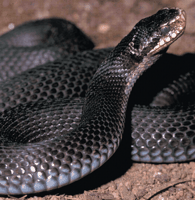This week in the BMJ
Volume 331,
Number 7527,
Issue of 26 Nov 2005
![[Down]](/icons/down.gif) How to treat snake bites
How to treat snake bites
![[Down]](/icons/down.gif) Dolphins help treat depression
Dolphins help treat depression
![[Down]](/icons/down.gif) Sleeping sicknesses might merge in Uganda
Sleeping sicknesses might merge in Uganda
![[Down]](/icons/down.gif) Foot and mouth epidemic had wide sequelae
Foot and mouth epidemic had wide sequelae
![[Down]](/icons/down.gif) How pets influence owners' health
How pets influence owners' health
How to treat snake bites
In a clinical review Warrell gives a comprehensive overview of the clinical features of adder and exotic snake bites, including their diagnosis and treatment (p 1244). The adder or viper (Vipera berus) is the only venomous snake indigenous to Great Britain, where about 100 adder bites to humans and a dozen to animals are reported yearly. Several cases of exotic snake bites are also reported yearly, mostly from private unlicenced individuals who like these "macho pets." What is the best course of action in such cases?
![[To top]](/icons/back.gif)
Dolphins help treat depression
Dolphins can help alleviate symptoms of depression after two weeks of treatment. In a single blind trial, Antonioli and Reveley (p 1231) randomised 30 people with mild or moderate depression without psychotic features to an outdoor nature programme featuring water activities—with or without bottlenose dolphins. Participants who got to play with the dolphins showed significantly greater reduction in the mean severity of depressive symptoms than those who only enjoyed other aspects of nature. None of the participants took any antidepressant or anxiolytic drugs for the four weeks before or during the study.

| |
Credit: NOMI BAUMGARTL/BILDERBERG/NETWORK
|
|
![[To top]](/icons/back.gif)
Sleeping sicknesses might merge in Uganda
Two foci of sleeping sickness caused by two different pathogens, Trypanosoma brucei rhodesiense (which causes an acute form of disease) and T b gambiense (which causes the chronic form), have been steadily converging and might soon merge in Uganda, causing major problems in diagnosis and treatment, if much needed public health interventions are not put in place. Picozzi and colleagues (p 1238) used polymerase chain reaction analysis to examine blood samples of 231 patients presenting with sleeping sickness between 2001 and 2005; they found that the foci have converged since the mid-1980s and are now only 150 km apart. The authors call for preventive actions targeted at the disease reservoir in livestock and monitoring with molecular diagnostic tools in livestock and humans.
![[To top]](/icons/back.gif)
Foot and mouth epidemic had wide sequelae
The epidemic of foot and mouth disease in the United Kingdom in 2001 had profound psychosocial effects on a wide range of rural workers and residents. Mort and colleagues (p 1234) conducted a qualitative, ethnographic, diary based study of 54 respondents from Cumbria (the worst affected area in Britain) and found that the epidemic caused considerable distress not only among farmers but also in other rural citizens. More traditional biomedical or health research methods could not have captured these effects of the epidemic, say the authors. The authors also provide recommendations to improve disaster management in the future.

| |
Credit: GREG WILLIAMS/REX
|
|
![[To top]](/icons/back.gif)
How pets influence owners' health
On page 1252 McNicholas and colleagues discuss the effects that pets might have on their owners' health. Studies in the 1980s suggested many beneficial effects of owning a pet, such as higher survival rates after myocardial infarction, but recent studies have failed to replicate many of these findings. However, pet ownership and health can be viewed in a wider context, say the authors, and discuss the effects that pets can have on wellbeing (physical and mental) and social integration.

| |
Credit: DAN CALLISTER/REX
|
|
![[To top]](/icons/back.gif)
How to treat snake bites
Dolphins help treat depression
Sleeping sicknesses might merge in Uganda
Foot and mouth epidemic had wide sequelae
How pets influence owners' health



